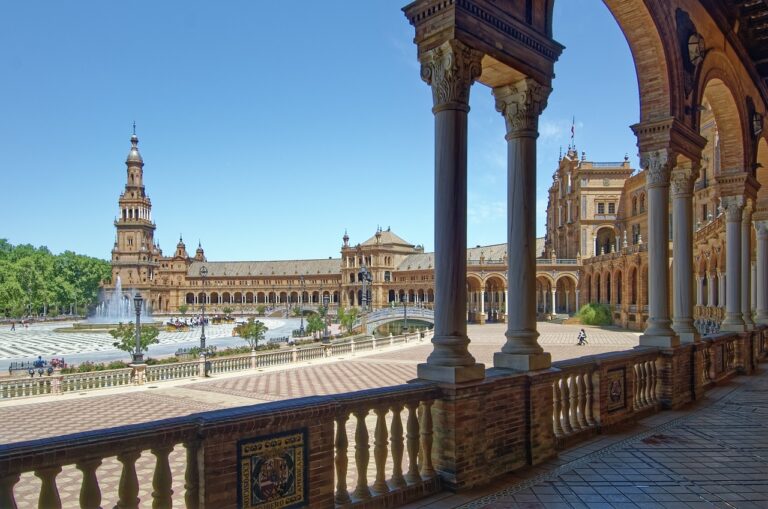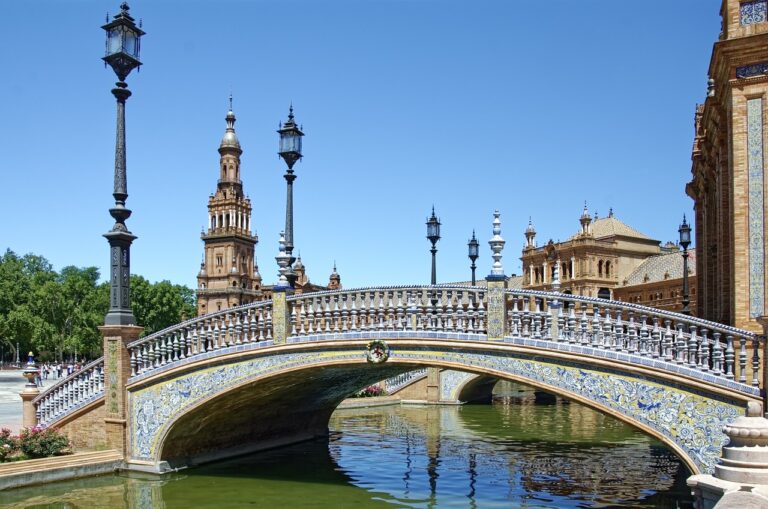Guide to Plaza de España
Plaza de España
Sevilla, the capital of Spain’s Andalusia region, is known for its rich history, vibrant culture, and stunning architecture. Among its many attractions, the Plaza de España stands out as one of the most impressive and iconic landmarks. Built for the Ibero-American Exposition of 1929, this grand square is a must-visit for anyone exploring the city. In this guide, we will take a closer look at the history, design, and key features of Plaza de España, as well as provide practical tips for making the most of your visit.
History of Plaza de España
The Ibero-American Exposition
The Plaza de España was constructed for the Ibero-American Exposition of 1929, an international fair aimed at strengthening ties between Spain and the countries of Latin America. Architect Aníbal González designed the square, and construction began in 1914, taking 15 years to complete. The exposition showcased the cultural, industrial, and artistic achievements of participating nations, and the Plaza de España served as the centerpiece of the event.
A Symbol of Unity
The design of Plaza de España symbolizes Spain’s embrace of its former colonies. The square’s semi-circular shape represents the open arms of Spain welcoming its American territories. Today, the plaza remains a symbol of unity and a testament to Sevilla’s architectural grandeur.
Architectural Highlights of the Plaza de España
The Semi-Circular Building
The most striking feature of Plaza de España is its grand semi-circular building, which measures 170 meters in diameter. The building is a stunning example of Renaissance Revival architecture, with elements of Art Deco. It is adorned with intricate brickwork, colorful ceramic tiles, and elaborate towers at each end.
The Canal and Bridges
In front of the building, a large moat-like canal spans the square, crossed by four beautiful bridges. These bridges represent the four ancient kingdoms of Spain: Castile, León, Aragón, and Navarra. You can rent a small rowboat and paddle along the canal, enjoying the scenic views of the plaza.
The Central Fountain
At the center of the square stands a grand fountain, designed by Vicente Traver. The fountain adds to the plaza’s charm and is a popular spot for visitors to relax and take photos.
The Tile Benches
One of the most unique features of Plaza de España is the series of tiled alcoves or benches that line the walls of the semi-circular building. Each alcove represents a different province of Spain, with colorful ceramic tiles depicting historical scenes and maps from that region. These benches provide a beautiful and educational overview of Spain’s diverse provinces.

Key Features and Attractions of the Plaza de España
The Vicente Traver Fountain
The central fountain, designed by Vicente Traver, is a focal point of the plaza. The fountain’s graceful design and flowing water create a serene atmosphere, making it a popular spot for both tourists and locals to gather and relax. It is particularly beautiful when illuminated at night.
The Pavilions
Surrounding the Plaza de España are several pavilions that were built for the 1929 exposition. These pavilions, each representing a different country or region, showcase a variety of architectural styles and are now used for various cultural and governmental purposes. The nearby Maria Luisa Park, which houses many of these pavilions, is a great place to explore and enjoy the beautiful gardens.
Boat Rentals
One of the most enjoyable activities at Plaza de España is renting a rowboat and paddling along the canal. This gives you a unique perspective of the plaza and allows you to appreciate the stunning architecture from the water. Boat rentals are available throughout the day, and it is a fun activity for families and couples.
Horse-Drawn Carriages
For a more traditional and romantic way to explore the plaza, consider taking a ride in a horse-drawn carriage. These carriages are available for hire around the plaza and provide a leisurely way to take in the sights. The gentle clip-clop of the horses’ hooves and the grandeur of the surroundings make for an unforgettable experience.
Practical Information for Visitors of the Plaza de España
Opening Hours and Admission
Plaza de España is open to the public 24 hours a day, seven days a week, and there is no admission fee. This makes it an accessible and affordable attraction for all visitors. The surrounding buildings and pavilions may have different opening hours, so it is advisable to check ahead if you plan to visit any specific exhibits or museums.
Getting There
Plaza de España is located in the heart of Sevilla, within Maria Luisa Park. It is easily accessible by public transportation, with several bus and tram stops nearby. The closest metro station is Prado de San Sebastián, which is just a short walk from the plaza. If you prefer to drive, there are parking facilities in the area, but be prepared for limited availability during peak times.
Best Times to Visit
To avoid the crowds and enjoy a more peaceful experience, it is best to visit Plaza de España early in the morning or late in the afternoon. The plaza is particularly beautiful at sunset when the golden light bathes the buildings in a warm glow. Evening visits are also enjoyable, as the plaza is beautifully illuminated, creating a magical atmosphere.

Tips for Visitors of the Plaza de España
- Wear Comfortable Shoes: The plaza and its surroundings cover a large area, and you will be doing a lot of walking. Comfortable shoes are essential.
- Stay Hydrated: Sevilla can get very hot, especially in the summer months. Make sure to bring water and stay hydrated during your visit.
- Bring a Camera: Plaza de España is incredibly photogenic, with countless opportunities for stunning photos. Don’t forget your camera or smartphone to capture the beauty of the plaza.
- Take Your Time: There is so much to see and explore at Plaza de España. Take your time to wander around, sit on the tiled benches, and soak in the atmosphere.
Nearby Attractions
Maria Luisa Park
Adjacent to Plaza de España is the expansive Maria Luisa Park, one of the most beautiful parks in Sevilla. The park is home to several other important landmarks, including the Museum of Arts and Traditions and the Archaeological Museum. It is a great place to enjoy a leisurely stroll, have a picnic, or simply relax in the shade of the trees.
Just a short walk from Plaza de España is the Cathedral of Sevilla, the largest Gothic cathedral in the world. The cathedral is a UNESCO World Heritage site and houses the tomb of Christopher Columbus. Don’t miss the opportunity to climb the Giralda bell tower for panoramic views of the city.
Another must-visit attraction near Plaza de España is the Real Alcázar of Sevilla. This royal palace, originally built by Moorish Muslim kings, is renowned for its stunning architecture and beautiful gardens. The Alcázar is also a UNESCO World Heritage site and offers a fascinating glimpse into Sevilla’s rich history.
Conclusion
Plaza de España is a true gem in the heart of Sevilla. Its stunning architecture, historical significance, and vibrant atmosphere make it a must-visit destination for anyone exploring the city. Whether you are paddling along the canal, relaxing by the fountain, or simply taking in the beauty of the surroundings, Plaza de España offers a unique and unforgettable experience. Make sure to include this iconic landmark in your Sevilla itinerary, and take the time to explore and appreciate all that it has to offer.
